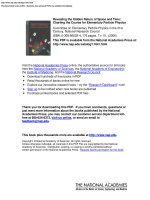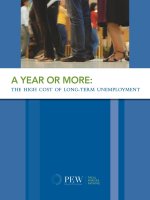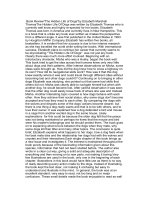The hidden cost of food
Bạn đang xem bản rút gọn của tài liệu. Xem và tải ngay bản đầy đủ của tài liệu tại đây (2.31 MB, 10 trang )
The Hidden Cost of Food
The use of resources and our
environment for food production
Brandi Hacker
The Future of Creation
May 6, 2008
From Farms…
Industrial farms are
major sources
pollution
– Air
/>
• Methane and other
gases emitted
– Water
•
•
•
•
•
/>
Nutrients
Ammonia and Nitrates
Antibiotics
Heavy metals and salts
Water usage
… to the shelves
Fossil Fuels are used
Our food has to travel
– By planes, trains, trucks,
and ships
Most fresh fruits and
vegetables in the U.S.
are shipped from CA,
FL, and WA.
Fruits and vegetables
spend 7 to 14 days in
transit before they
arrive in the store.
/>
Where Our Food Comes From
QuickTime™ and a
TIFF (LZW) decompressor
are needed to see this picture.
Agriculture Footprint Brief. July 2003
Food Miles= miles
traveled from farm
to tables
Broccoli
– Grown within 20
miles of most
homes in United
States
– At supermarket
travels 1,800 miles
to get there
“The Issues Introductio.”
The True Cost of Food
Visit
www.truecostoffood.org.
– View the movie as an
introduction to this
complex issue
Use the discussion guide
to begin the conversation
in your congregation and
other local groups
Facts from the Movie
A gallon of oil is used
per pound of beef.
Twenty-five hundred
gallons of water for
each pound of steak.
For every 10 pounds
of healthy grain you
put into a cow, you
only get out one
pound of meat.
Worldwide, we chop
down an acre of
rainforest every
minute, and lose
millions of
grasslands acres a
year, to feed and
graze cattle.
Factory farm runoff
has poisoned the
ground water in 17
states and has
polluted 35,000
miles of America's
Facts… Continued
16% of the methane
comes from animals.
Mono-cropped fields
are doused with one
billion pounds of toxic
pesticides a year.
Short-sighted practices
make the earth lose 24
billion tons of topsoil a
year.
You need more and
more chemicals all the
time, to get the same
results
In 2002, the largest
10% of farms collected
65% of the subsidies;
the bottom half got
2%--$256 a year.
7 % of our farms sell
72% of our food.
Eating local saves up
to 17 times the gas
costs of food you buy
in the supermarket.
The organic food
market is growing at
25 percent a year.
Individuals Can Help
Eat in Season
Shop for locally grown
food
Encourage others to
eat and shop local
Learn about a local
farm
Host a harvest party
Put together a local
food directory
Experiment with
drying, canning, or
preserving in season
fruit for later
Plant a garden
Speak to your local
politician
Worldwatch Paper #163, 59.
Questions for Thought…
What surprised you in the information?
Name one thing you could do to start
shopping more locally.
– Or to help others shop locally.
Works Cited
Deumling, Diana, Mathis Wackernagel, and Chad Monfreda. “Eating Up the Earth: How Sustainable Food
Systems Shrink Our Ecological Footprint.” Agriculture Footprint Brief. July 2003. Available from
Accessed 5 May 2008.
“Guide for Discussion Leaders.” The True Cost of Food. 4 May 2008.
/>Halweil, Brian. “Worldwatch Paper #163: Home Grown: The Case For Local Food In A Global Market.”
World Watch Institute. November 2002.
“See the Movie!” The True Cost of Food. 4 May 2008.
/>“The Issues: Air Pollution.” Sustainable Table Serving Up Healthy Food Choices. 5 May 2008.
/>“The Issues Introduction.” Sustainable Table Serving Up Healthy Food Choices. 5 May 2008
/>“The Issues: Water Pollution.” Sustainable Table Serving Up Healthy Food Choices. 5 May 2008.
/>“Where does our food come from?” FoodRoutes.org. 4 May 2008. p









